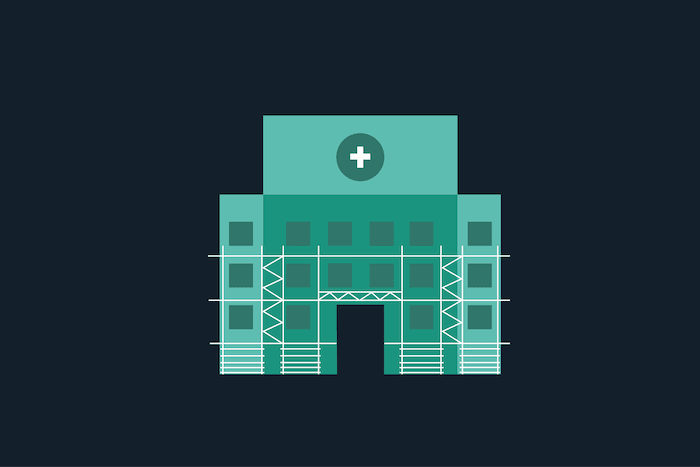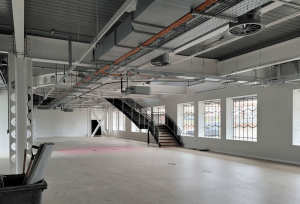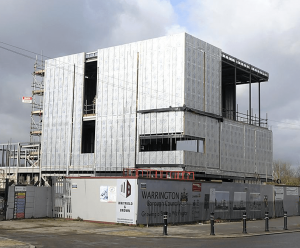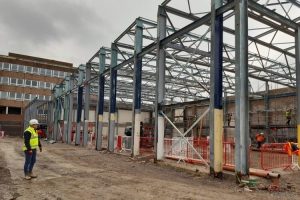The Department of Health and Social Care (DHSC) announced its Healthcare Infrastructure Plan (HIP) in 2019, outlining how NHS capital funding will be prioritised and allocated to trusts across 2020-2030 to improve hospitals, infrastructure, and frontline services. A rolling 5-year programme of investment will see the plan deliver capital investment for new build hospitals, modernisation of the primary care estate, an improvement to mental health facilities, financial support to advance diagnostics and technology, and stamp out serious safety issues across the NHS. This is a much-needed boost to the investment of our NHS estate, which has faced both new and historical challenges, worsened by the immense strain placed on services and budgets throughout the Covid-19 pandemic.
With an opportunity now for the UK to ‘build back better,’ Key Account Manager Conor Neild-Crabb, with support from Hive Projects Director Liz Hartley, will explore the complexity of healthcare construction projects and the benefits of early market testing in the procurement process to allow priority projects to get underway.
HIP Funding and Objectives
The strategic objective of the Health Infrastructure Plan is to improve our hospitals and health infrastructure in an effective, collaborative, and sustainable way. Through long-term investment, mistakes of the past can be avoided, such as the stop-start nature of the millennium hospital building programme, keeping multifaceted hospital projects on track and the multi-disciplinary teams involved committed and engaged, allowing project teams to plan the pipeline of future investment. So far, £600m has been invested through a Critical Infrastructure Fund involving 178 NHS Trusts to help clear the critical maintenance backlog, £850m has been pumped into upgrading and refurbishing 20 hospitals, and £3.7bn has been pledged to help build 40 new hospitals by 2030. Funding provisions have also been made for mental health facilities and improvements to A&E departments.
Following Brexit and the UK economic recovery from the pandemic, the Government are determined to ‘level up’ the UK and create a world-class National Health Service. The recently revised version of the HIP will focus on:
• the strategy for new hospitals and hospital upgrades, including expected standards
• the primary care estate, including getting the most out of primary care hubs
• how technology should be most effectively deployed in the NHS
• the strategy to deliver on sustainability and carbon net zero emissions by 2050
The Complexity of Healthcare Construction Projects
Hospital and healthcare construction projects are among the most complex and challenging within the construction industry and incur the highest risk of unforeseen problems. This is largely due to the slow pace at which healthcare projects move. Teams who have never worked together before are brought in from across the country to work on complex structures that have intricate Mechanical, Electrical and Plumbing (MEP) systems and the buildings often need to remain operational whilst works are carried out. Large-scale projects need to be approached strategically and collaboratively throughout the project lifecycle to keep budgets, timelines, and revenue on track, but the complexity of these types of projects and the number of different teams involved can pose unique challenges that when not carefully managed, can cause fractions, delays or even grind the project to a complete standstill. Healthcare construction projects demand flexibility, innovation and complete transparency and collaboration across all capital, procurement, and contractor teams. However, it is possible to deliver highly complex hospital facilities at fast pace, with the Nightingale Hospitals being testament to that. Impressively it took only 9 days to equip and fit 500 intensive care beds in seven ‘pop up’ locations, with the support of 160 contractors, establishing a critical care provision for 4,000 Covid-19 patients. This highlights the importance of what can be achieved when the Government, health professionals and a robust Health Systems Support Framework work successfully and collaboratively together.
The Benefits of Early Contractor Engagement
Once the most suitable procurement route for the proposed healthcare project has been established, it is important to begin the procurement process by engaging early on with potential contractors. A soft market test is a preferential purchasing activity, designed to test the commercial market of its capabilities to meet the specific set of requirements for the project type, which would include enough interested contractors to maintain a competitive process. The best avenue to achieve this with construction projects is to issue contractors with a Project Initiation Form (PIF). This document defines the project scope, the management, and overall key criteria of the project, so bid teams have transparency over the basic context and specification of the project’s design and build. This allows contractors to get involved at the early stages and allocate resources for bidding, make informed decisions, and establish if this is the right contract for them. Open communication and access to the project details early in the process improves the retention rate of bidders throughout the exercise.
Via a Two-stage tendering route, interested contractors then receive the tender documentation. For the single-stage route, a formal Expression of Interest (EOI) is requested, for keen parties to formally identify their commitment in proceeding to the tender stage. To achieve high quality bid submissions and to keep contractors engaged throughout the life of the tender process, tender documentation should clearly outline the works required, including the design, and often decompartmentalise the tender into a range of packages or lots. The main benefit of early contractor engagement is that it improves the rate of success in finding the right contractors with the right capabilities to deliver the project’s specific goals and objectives.
The Benefits of Enabling Packages
Healthcare projects involve vast numbers of professional teams forming a complex project plan and programme of works. Separating the enabling works from the main works can allow the project to progress more quickly, as they can be carried out whilst the design for the main scope of the project is being developed. Enabling works refers to the site preparation that takes place prior to the construction works carried out by the main contractor. This could include infrastructure diversions, roads, demolition, site clearance, surveys or wildlife or tree protection to name but a few. With large-scale projects splitting out the enabling works into separate packages allows teams to get onto the site quicker to carry out the preliminaries, saves time and money helping to keep the project moving within the proposed timeframes and budget, and allows for specialist contractors to be appointed to carry out specific contracts. Enabling works are carried out ahead of mobilisation activities. These activities take place after a contractor has been appointed but before construction works are carried out on site. There are significant benefits in batching projects together for a programme of works, which include consolidation of the workforce required on site, cost savings on prelims, builds trust between the client and contractor, materials can be ordered in bulk, and mobilisation of the project can happen a lot quicker as the contractual process is less complicated when a main contractor heads up the programme of works.
Liz Hartley, Director at Hive Projects, Commented: “In this post covid climate, early engagement with Contractors and Supply Chains is more important than ever, not only to align the cost to the current challenging market positions but to optimise efficiencies through the design. Value for money is high on the agenda in the delivery of healthcare schemes, early engagement allows us to work collaboratively with a Contractor driving this through in all aspects of procurement, buildability and design, avoiding lengthy value engineering exercises and programme delays. Appointing the right contractor at the right time can be fundamental in our ability as a team to support the New Hospital Programme with innovative and sustainable designs prioritising standardisation, digital technology and modern methods of construction.”
Click Here To Download a Procure Partnerships Framework User Guide
Twitter
Linkedin

In Conor’s 7/8 years in the industry, he has emerged as an expert in procurement, demonstrating a profound understanding of structuring Procure Partnerships Frameworks, deciphering main contractor/consultant procurement intricacies, assessing competitor offerings, and steering special projects and new product development.



